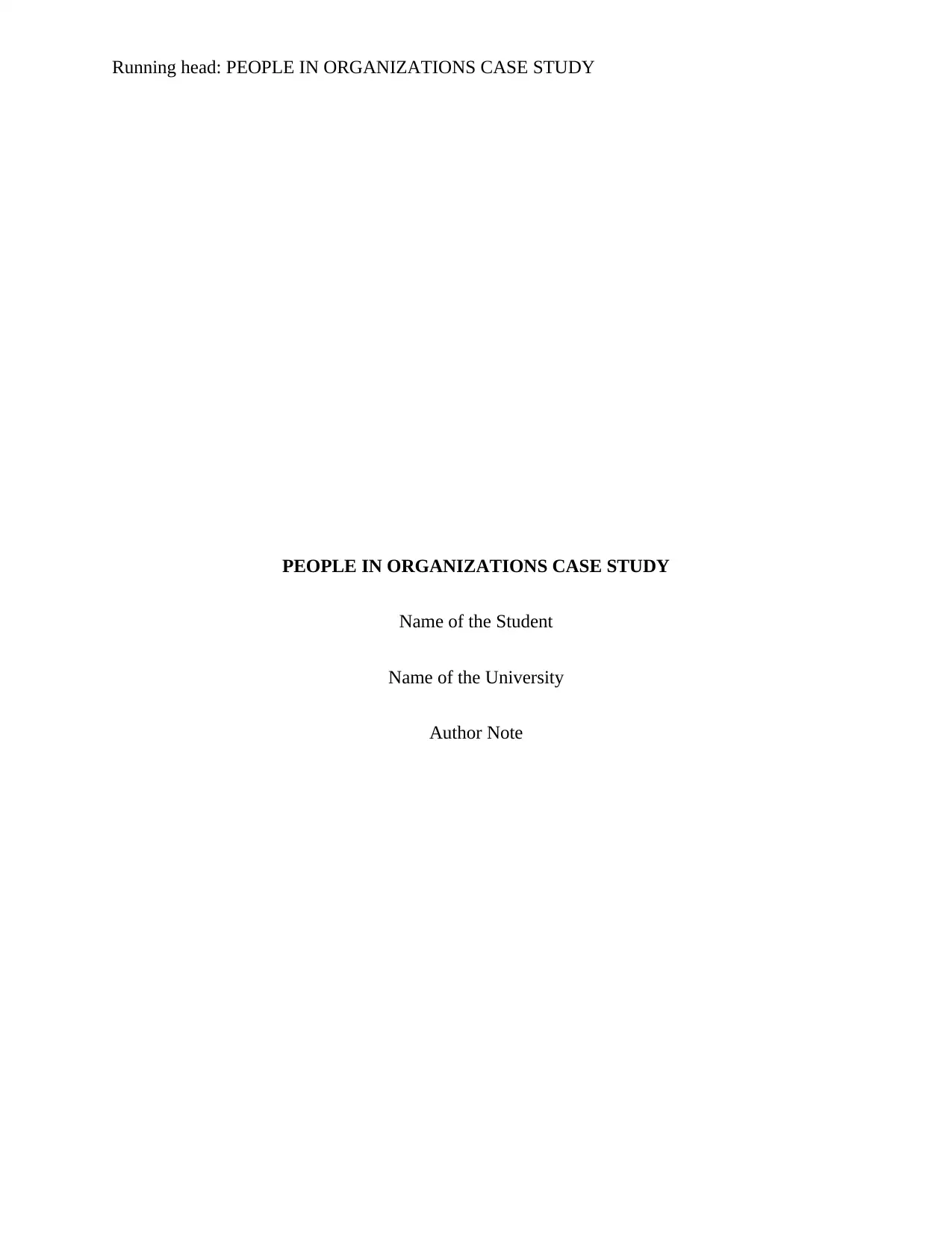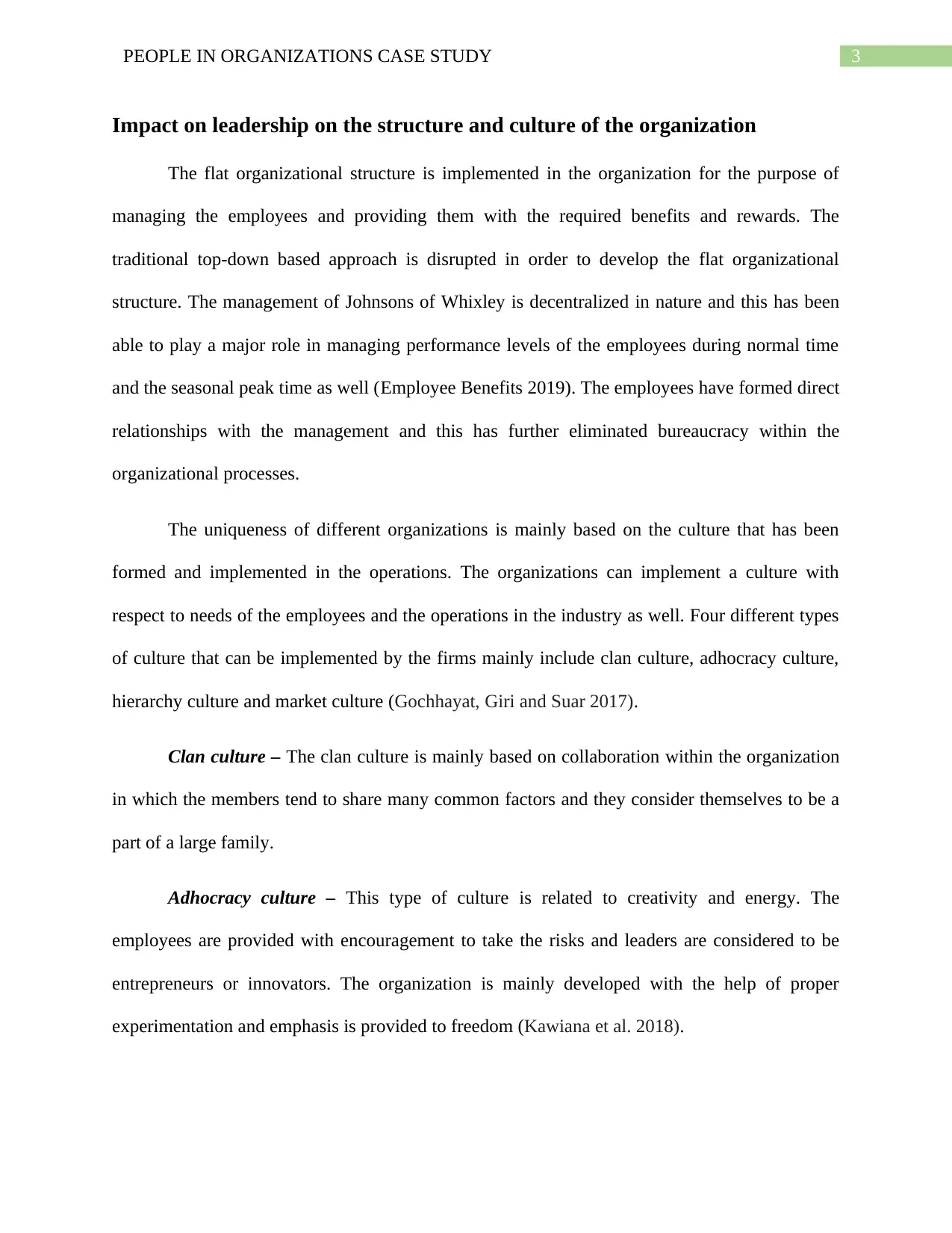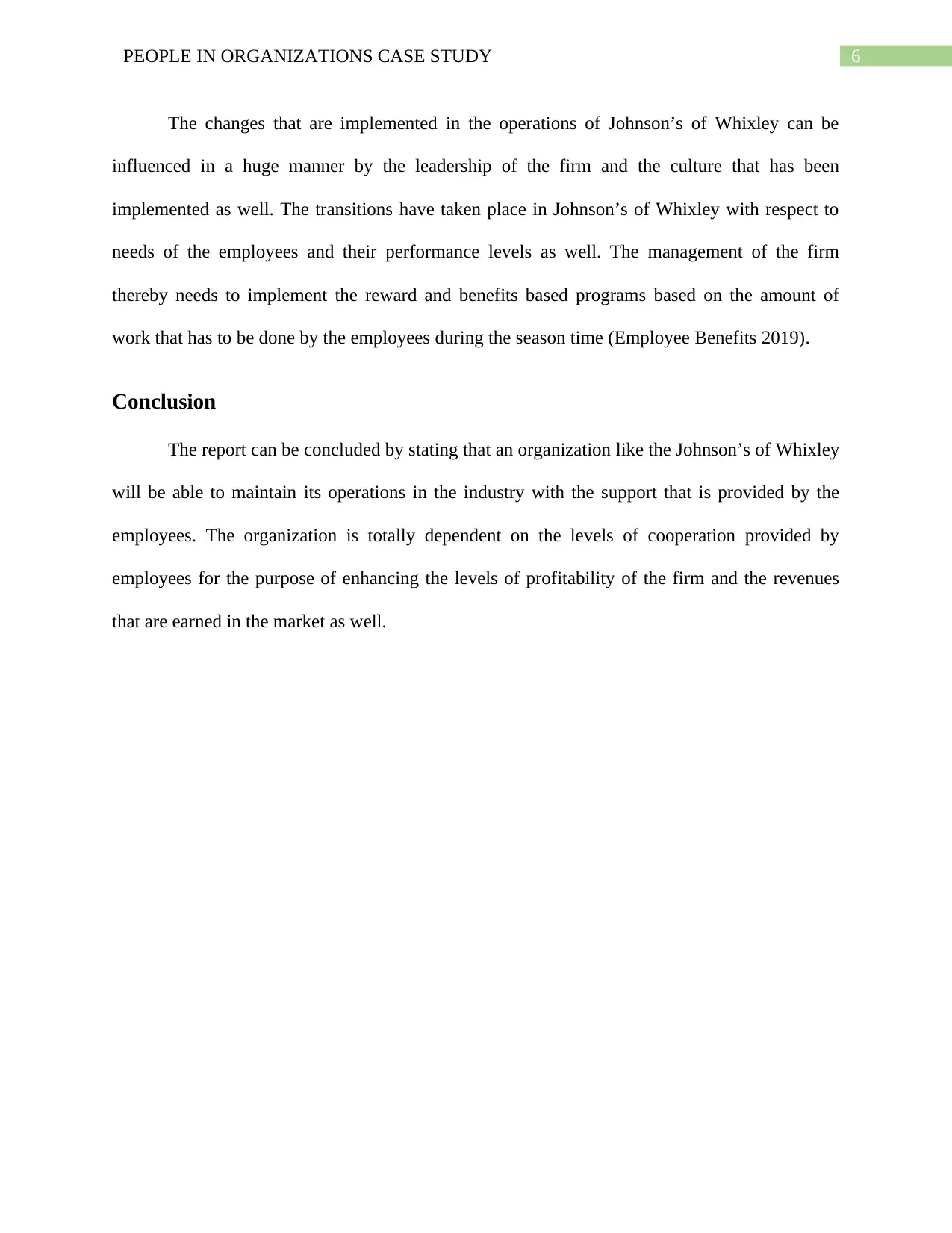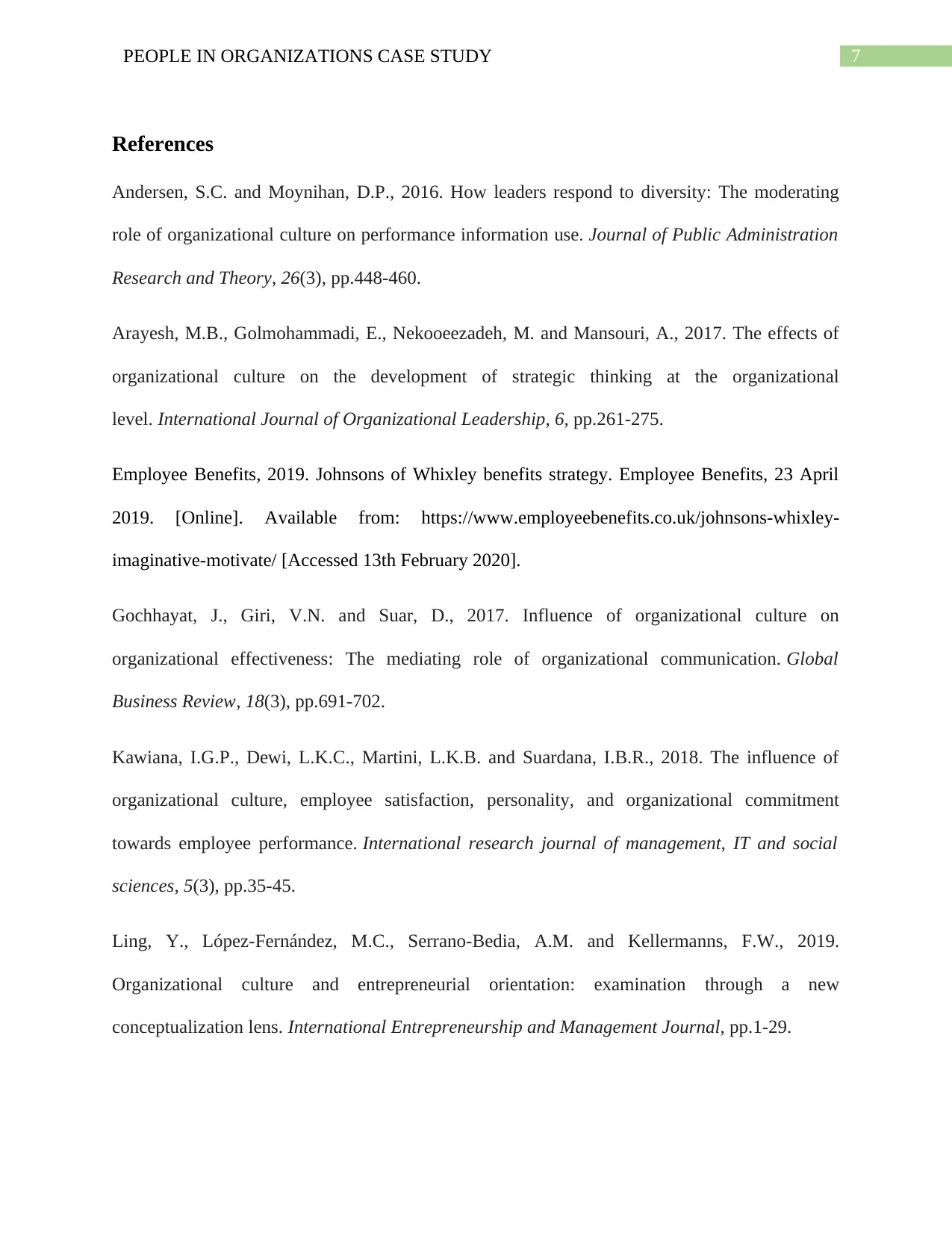People in Organizations: Johnson's of Whixley Case Study
VerifiedAdded on 2022/08/14
|9
|1901
|17
Case Study
AI Summary
This case study analyzes the impact of leadership on organizational culture and structure, focusing on Johnson's of Whixley, a company known for its flexible approach to employee rewards. The study examines the role of leadership in shaping the company's flat organizational structure and market culture, emphasizing the importance of employee benefits and annual profit sharing. It explores how transformational leadership influences transitional changes, particularly in response to seasonal fluctuations in the workforce. The analysis highlights the importance of aligning reward systems with employee performance and the overall impact of leadership on maintaining operational effectiveness and employee motivation. The case study concludes that the organization's success is highly dependent on employee cooperation and the ability of leaders to adapt to changing circumstances.

Running head: PEOPLE IN ORGANIZATIONS CASE STUDY
PEOPLE IN ORGANIZATIONS CASE STUDY
Name of the Student
Name of the University
Author Note
PEOPLE IN ORGANIZATIONS CASE STUDY
Name of the Student
Name of the University
Author Note
Paraphrase This Document
Need a fresh take? Get an instant paraphrase of this document with our AI Paraphraser

1PEOPLE IN ORGANIZATIONS CASE STUDY
Table of Contents
Introduction......................................................................................................................................2
Leadership in the organization.........................................................................................................2
Impact on leadership on the structure and culture of the organization............................................3
Transitional change based on leadership in the organization..........................................................4
Conclusion.......................................................................................................................................6
References........................................................................................................................................7
Table of Contents
Introduction......................................................................................................................................2
Leadership in the organization.........................................................................................................2
Impact on leadership on the structure and culture of the organization............................................3
Transitional change based on leadership in the organization..........................................................4
Conclusion.......................................................................................................................................6
References........................................................................................................................................7

2PEOPLE IN ORGANIZATIONS CASE STUDY
Introduction
The case study that will be analyzed in the report is mainly based on the organization
named Johnson’s of Whixley that mainly implements an imaginative and flexible approach for
the purpose of rewarding the workforce. The organization has employed around 90 members of
the staff and the numbers tend to increase at the time of seasonal peaks (Employee Benefits
2019). The report will be based on analysis of impact that leadership has on the culture and
structure of organizations. The transitional changes that have taken place in the organizations
will also be analyzed in the report with respect to the impact that leadership has been able to
develop.
Leadership in the organization
The leadership of Johnson’s of Whixley has been able to play a major role in
understanding the needs of the employees who are a part of the firm. The changes that take place
in the employee base of the firm based on the normal operations and peak operations have been
taken into consideration for the purpose of developing the reward and benefits based programs.
The organization is highly dependent on the employees for the purpose of maintaining its
operations and gaining profits as well (Arayesh et al. 2017). The benefits that are offered to
employees are mainly based on the size of business and the services that are provided to the
organization as well. The managing director of Johnsons of Whixley has been able to play a
major leadership based role in order to develop the strategies that are related to rewards and
benefits of the employees. Annual profit share is also an important aspect related to the reward
based programs that have been formed by the organization (Andersen and Moynihan 2016).
Introduction
The case study that will be analyzed in the report is mainly based on the organization
named Johnson’s of Whixley that mainly implements an imaginative and flexible approach for
the purpose of rewarding the workforce. The organization has employed around 90 members of
the staff and the numbers tend to increase at the time of seasonal peaks (Employee Benefits
2019). The report will be based on analysis of impact that leadership has on the culture and
structure of organizations. The transitional changes that have taken place in the organizations
will also be analyzed in the report with respect to the impact that leadership has been able to
develop.
Leadership in the organization
The leadership of Johnson’s of Whixley has been able to play a major role in
understanding the needs of the employees who are a part of the firm. The changes that take place
in the employee base of the firm based on the normal operations and peak operations have been
taken into consideration for the purpose of developing the reward and benefits based programs.
The organization is highly dependent on the employees for the purpose of maintaining its
operations and gaining profits as well (Arayesh et al. 2017). The benefits that are offered to
employees are mainly based on the size of business and the services that are provided to the
organization as well. The managing director of Johnsons of Whixley has been able to play a
major leadership based role in order to develop the strategies that are related to rewards and
benefits of the employees. Annual profit share is also an important aspect related to the reward
based programs that have been formed by the organization (Andersen and Moynihan 2016).
⊘ This is a preview!⊘
Do you want full access?
Subscribe today to unlock all pages.

Trusted by 1+ million students worldwide

3PEOPLE IN ORGANIZATIONS CASE STUDY
Impact on leadership on the structure and culture of the organization
The flat organizational structure is implemented in the organization for the purpose of
managing the employees and providing them with the required benefits and rewards. The
traditional top-down based approach is disrupted in order to develop the flat organizational
structure. The management of Johnsons of Whixley is decentralized in nature and this has been
able to play a major role in managing performance levels of the employees during normal time
and the seasonal peak time as well (Employee Benefits 2019). The employees have formed direct
relationships with the management and this has further eliminated bureaucracy within the
organizational processes.
The uniqueness of different organizations is mainly based on the culture that has been
formed and implemented in the operations. The organizations can implement a culture with
respect to needs of the employees and the operations in the industry as well. Four different types
of culture that can be implemented by the firms mainly include clan culture, adhocracy culture,
hierarchy culture and market culture (Gochhayat, Giri and Suar 2017).
Clan culture – The clan culture is mainly based on collaboration within the organization
in which the members tend to share many common factors and they consider themselves to be a
part of a large family.
Adhocracy culture – This type of culture is related to creativity and energy. The
employees are provided with encouragement to take the risks and leaders are considered to be
entrepreneurs or innovators. The organization is mainly developed with the help of proper
experimentation and emphasis is provided to freedom (Kawiana et al. 2018).
Impact on leadership on the structure and culture of the organization
The flat organizational structure is implemented in the organization for the purpose of
managing the employees and providing them with the required benefits and rewards. The
traditional top-down based approach is disrupted in order to develop the flat organizational
structure. The management of Johnsons of Whixley is decentralized in nature and this has been
able to play a major role in managing performance levels of the employees during normal time
and the seasonal peak time as well (Employee Benefits 2019). The employees have formed direct
relationships with the management and this has further eliminated bureaucracy within the
organizational processes.
The uniqueness of different organizations is mainly based on the culture that has been
formed and implemented in the operations. The organizations can implement a culture with
respect to needs of the employees and the operations in the industry as well. Four different types
of culture that can be implemented by the firms mainly include clan culture, adhocracy culture,
hierarchy culture and market culture (Gochhayat, Giri and Suar 2017).
Clan culture – The clan culture is mainly based on collaboration within the organization
in which the members tend to share many common factors and they consider themselves to be a
part of a large family.
Adhocracy culture – This type of culture is related to creativity and energy. The
employees are provided with encouragement to take the risks and leaders are considered to be
entrepreneurs or innovators. The organization is mainly developed with the help of proper
experimentation and emphasis is provided to freedom (Kawiana et al. 2018).
Paraphrase This Document
Need a fresh take? Get an instant paraphrase of this document with our AI Paraphraser

4PEOPLE IN ORGANIZATIONS CASE STUDY
Market culture – The market culture is mainly developed upon dynamics of the
competition and the ways by which concrete results can be achieved as well. The focus of market
culture is considered to be goal-oriented as the leaders in this case can demanding and tough in
nature.
Hierarchy culture – The hierarchical organizational culture is mainly developed with
respect to control and structure. The work environment in this case is considered to be formal in
nature and the institutional procedures are also implemented for proper guidance (Ling et al.
2019).
The market culture has been implemented in Johnsons of Whixley for the purpose of
achieving the goals and objectives that have been set by the organization. The common goals that
have been set by the organization has been communicated to the employees so that they able to
provide their contribution to the success that is gained in the industry (Naranjo‐Valencia,
Jimenez‐Jimenez and Sanz‐Valle 2017). The profitability levels and shares that have been gained
by the organization in the market are considered to be major drivers of the culture that has been
implemented. The market culture has been able to play a major role in ensuring that an
organization like Johnson’s of Whixley can maintain its operations effectively during the season
time. The levels of motivation among employees can also be maintained with the support that is
provided by a collaborative market culture of the organization (Nikpour 2017).
Transitional change based on leadership in the organization
The management of Johnson’s of Whixley has aimed at the development of operations in
so that employees are able to provide the best of their performance in different situations that
they are facing. The changes that are implemented in the organization are also based on the
Market culture – The market culture is mainly developed upon dynamics of the
competition and the ways by which concrete results can be achieved as well. The focus of market
culture is considered to be goal-oriented as the leaders in this case can demanding and tough in
nature.
Hierarchy culture – The hierarchical organizational culture is mainly developed with
respect to control and structure. The work environment in this case is considered to be formal in
nature and the institutional procedures are also implemented for proper guidance (Ling et al.
2019).
The market culture has been implemented in Johnsons of Whixley for the purpose of
achieving the goals and objectives that have been set by the organization. The common goals that
have been set by the organization has been communicated to the employees so that they able to
provide their contribution to the success that is gained in the industry (Naranjo‐Valencia,
Jimenez‐Jimenez and Sanz‐Valle 2017). The profitability levels and shares that have been gained
by the organization in the market are considered to be major drivers of the culture that has been
implemented. The market culture has been able to play a major role in ensuring that an
organization like Johnson’s of Whixley can maintain its operations effectively during the season
time. The levels of motivation among employees can also be maintained with the support that is
provided by a collaborative market culture of the organization (Nikpour 2017).
Transitional change based on leadership in the organization
The management of Johnson’s of Whixley has aimed at the development of operations in
so that employees are able to provide the best of their performance in different situations that
they are facing. The changes that are implemented in the organization are also based on the

5PEOPLE IN ORGANIZATIONS CASE STUDY
collaborative culture that is followed by the employees. The leadership of Johnson’s of Whixley
also has been able to influence the culture that has been implemented within the organization.
The managing director of Johnson’s of Whixley has aimed at becoming a transformational leader
(Taylor, Santiago and Hynes 2019).
The transformational leadership process is mainly based on the ways by which leaders
aim at communicating their vision to the employees in order to improve their work process. The
employees provide their contribution towards proper fulfillment of the objectives that have been
set by the management. The rewards and benefits based strategy of the firm is also based on the
performance levels of the employees and improvement of revenues that have been gained in the
industry as well. The benefits that are offered to employees are considered to be proportionate to
size of a particular business organization (Warrick 2017). The employees of Johnson’s of
Whixley are considered to be the most important part of the profitability and market share that
has been gained by the organization. The leader of the firm is thereby responsible to take care of
the rewards and levels of recognition that are provided to the employees (Taylor, Santiago and
Hynes 2019).
The reward programs of Johnson’s of Whixley have been developed with respect to the
performance levels that are depicted by the employees. The leaders of the firm have been able to
play a major role recognizing the efforts that are provided by the employees. The employees of
the organization also have the ability to understand the levels of remuneration that can be
provided to them with respect to the size of the business (Naranjo‐Valencia, Jimenez‐Jimenez
and Sanz‐Valle 2017). The fluctuations that take place in size of the employee base have been
able to influence the reward systems that are formed by the management of Johnson’s of
Whixley.
collaborative culture that is followed by the employees. The leadership of Johnson’s of Whixley
also has been able to influence the culture that has been implemented within the organization.
The managing director of Johnson’s of Whixley has aimed at becoming a transformational leader
(Taylor, Santiago and Hynes 2019).
The transformational leadership process is mainly based on the ways by which leaders
aim at communicating their vision to the employees in order to improve their work process. The
employees provide their contribution towards proper fulfillment of the objectives that have been
set by the management. The rewards and benefits based strategy of the firm is also based on the
performance levels of the employees and improvement of revenues that have been gained in the
industry as well. The benefits that are offered to employees are considered to be proportionate to
size of a particular business organization (Warrick 2017). The employees of Johnson’s of
Whixley are considered to be the most important part of the profitability and market share that
has been gained by the organization. The leader of the firm is thereby responsible to take care of
the rewards and levels of recognition that are provided to the employees (Taylor, Santiago and
Hynes 2019).
The reward programs of Johnson’s of Whixley have been developed with respect to the
performance levels that are depicted by the employees. The leaders of the firm have been able to
play a major role recognizing the efforts that are provided by the employees. The employees of
the organization also have the ability to understand the levels of remuneration that can be
provided to them with respect to the size of the business (Naranjo‐Valencia, Jimenez‐Jimenez
and Sanz‐Valle 2017). The fluctuations that take place in size of the employee base have been
able to influence the reward systems that are formed by the management of Johnson’s of
Whixley.
⊘ This is a preview!⊘
Do you want full access?
Subscribe today to unlock all pages.

Trusted by 1+ million students worldwide

6PEOPLE IN ORGANIZATIONS CASE STUDY
The changes that are implemented in the operations of Johnson’s of Whixley can be
influenced in a huge manner by the leadership of the firm and the culture that has been
implemented as well. The transitions have taken place in Johnson’s of Whixley with respect to
needs of the employees and their performance levels as well. The management of the firm
thereby needs to implement the reward and benefits based programs based on the amount of
work that has to be done by the employees during the season time (Employee Benefits 2019).
Conclusion
The report can be concluded by stating that an organization like the Johnson’s of Whixley
will be able to maintain its operations in the industry with the support that is provided by the
employees. The organization is totally dependent on the levels of cooperation provided by
employees for the purpose of enhancing the levels of profitability of the firm and the revenues
that are earned in the market as well.
The changes that are implemented in the operations of Johnson’s of Whixley can be
influenced in a huge manner by the leadership of the firm and the culture that has been
implemented as well. The transitions have taken place in Johnson’s of Whixley with respect to
needs of the employees and their performance levels as well. The management of the firm
thereby needs to implement the reward and benefits based programs based on the amount of
work that has to be done by the employees during the season time (Employee Benefits 2019).
Conclusion
The report can be concluded by stating that an organization like the Johnson’s of Whixley
will be able to maintain its operations in the industry with the support that is provided by the
employees. The organization is totally dependent on the levels of cooperation provided by
employees for the purpose of enhancing the levels of profitability of the firm and the revenues
that are earned in the market as well.
Paraphrase This Document
Need a fresh take? Get an instant paraphrase of this document with our AI Paraphraser

7PEOPLE IN ORGANIZATIONS CASE STUDY
References
Andersen, S.C. and Moynihan, D.P., 2016. How leaders respond to diversity: The moderating
role of organizational culture on performance information use. Journal of Public Administration
Research and Theory, 26(3), pp.448-460.
Arayesh, M.B., Golmohammadi, E., Nekooeezadeh, M. and Mansouri, A., 2017. The effects of
organizational culture on the development of strategic thinking at the organizational
level. International Journal of Organizational Leadership, 6, pp.261-275.
Employee Benefits, 2019. Johnsons of Whixley benefits strategy. Employee Benefits, 23 April
2019. [Online]. Available from: https://www.employeebenefits.co.uk/johnsons-whixley-
imaginative-motivate/ [Accessed 13th February 2020].
Gochhayat, J., Giri, V.N. and Suar, D., 2017. Influence of organizational culture on
organizational effectiveness: The mediating role of organizational communication. Global
Business Review, 18(3), pp.691-702.
Kawiana, I.G.P., Dewi, L.K.C., Martini, L.K.B. and Suardana, I.B.R., 2018. The influence of
organizational culture, employee satisfaction, personality, and organizational commitment
towards employee performance. International research journal of management, IT and social
sciences, 5(3), pp.35-45.
Ling, Y., López-Fernández, M.C., Serrano-Bedia, A.M. and Kellermanns, F.W., 2019.
Organizational culture and entrepreneurial orientation: examination through a new
conceptualization lens. International Entrepreneurship and Management Journal, pp.1-29.
References
Andersen, S.C. and Moynihan, D.P., 2016. How leaders respond to diversity: The moderating
role of organizational culture on performance information use. Journal of Public Administration
Research and Theory, 26(3), pp.448-460.
Arayesh, M.B., Golmohammadi, E., Nekooeezadeh, M. and Mansouri, A., 2017. The effects of
organizational culture on the development of strategic thinking at the organizational
level. International Journal of Organizational Leadership, 6, pp.261-275.
Employee Benefits, 2019. Johnsons of Whixley benefits strategy. Employee Benefits, 23 April
2019. [Online]. Available from: https://www.employeebenefits.co.uk/johnsons-whixley-
imaginative-motivate/ [Accessed 13th February 2020].
Gochhayat, J., Giri, V.N. and Suar, D., 2017. Influence of organizational culture on
organizational effectiveness: The mediating role of organizational communication. Global
Business Review, 18(3), pp.691-702.
Kawiana, I.G.P., Dewi, L.K.C., Martini, L.K.B. and Suardana, I.B.R., 2018. The influence of
organizational culture, employee satisfaction, personality, and organizational commitment
towards employee performance. International research journal of management, IT and social
sciences, 5(3), pp.35-45.
Ling, Y., López-Fernández, M.C., Serrano-Bedia, A.M. and Kellermanns, F.W., 2019.
Organizational culture and entrepreneurial orientation: examination through a new
conceptualization lens. International Entrepreneurship and Management Journal, pp.1-29.

8PEOPLE IN ORGANIZATIONS CASE STUDY
Naranjo‐Valencia, J.C., Jimenez‐Jimenez, D. and Sanz‐Valle, R., 2017. Organizational culture
and radical innovation: Does innovative behavior mediate this relationship?. Creativity and
Innovation Management, 26(4), pp.407-417.
Nikpour, A., 2017. The impact of organizational culture on organizational performance: The
mediating role of employee’s organizational commitment. International Journal of
Organizational Leadership, 6, pp.65-72.
Taylor, A., Santiago, F. and Hynes, R., 2019. Relationships among leadership, organizational
culture, and support for innovation. In Effective and Creative Leadership in Diverse
Workforces (pp. 11-42). Palgrave Macmillan, Cham.
Warrick, D.D., 2017. What leaders need to know about organizational culture. Business
Horizons, 60(3), pp.395-404.
Naranjo‐Valencia, J.C., Jimenez‐Jimenez, D. and Sanz‐Valle, R., 2017. Organizational culture
and radical innovation: Does innovative behavior mediate this relationship?. Creativity and
Innovation Management, 26(4), pp.407-417.
Nikpour, A., 2017. The impact of organizational culture on organizational performance: The
mediating role of employee’s organizational commitment. International Journal of
Organizational Leadership, 6, pp.65-72.
Taylor, A., Santiago, F. and Hynes, R., 2019. Relationships among leadership, organizational
culture, and support for innovation. In Effective and Creative Leadership in Diverse
Workforces (pp. 11-42). Palgrave Macmillan, Cham.
Warrick, D.D., 2017. What leaders need to know about organizational culture. Business
Horizons, 60(3), pp.395-404.
⊘ This is a preview!⊘
Do you want full access?
Subscribe today to unlock all pages.

Trusted by 1+ million students worldwide
1 out of 9
Related Documents
Your All-in-One AI-Powered Toolkit for Academic Success.
+13062052269
info@desklib.com
Available 24*7 on WhatsApp / Email
![[object Object]](/_next/static/media/star-bottom.7253800d.svg)
Unlock your academic potential
Copyright © 2020–2026 A2Z Services. All Rights Reserved. Developed and managed by ZUCOL.





